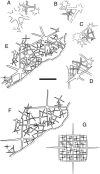Reconstructing early sponge relationships by using the Burgess Shale fossil Eiffelia globosa, Walcott
- PMID: 15665105
- PMCID: PMC547825
- DOI: 10.1073/pnas.0405867102
Reconstructing early sponge relationships by using the Burgess Shale fossil Eiffelia globosa, Walcott
Abstract
The relationships of the sponge classes are controversial, particularly between the calcareous and siliceous sponges. Specimens of the putative calcarean Eiffelia globosa Walcott from the Burgess Shale show the presence of diagnostic hexactinellid spicules integrated into the skeletal mesh. The arrangement of these spicules in Eiffelia is shown to be precisely equivalent to that of early protospongioid hexactinellids, and sponge growth occurred through an identical pattern to produce identical skeletal body morphology. The difference in spicule composition of the classes is interpreted through the observation of taphonomic features of Eiffelia that suggest the presence of at least two mineralogically distinct layers within the spicules. These results support molecular analyses that identify the calcarean-silicisponge transition as the earliest major sponge branch and suggest that the heteractinids were paraphyletic with respect to the Hexactinellida.
Figures





References
-
- Brasier, M. D., Green, O. & Shields, G. (1997) Geology 25, 303-306.
-
- Gehling, J. G. & Rigby, J. K. (1996) J. Paleontol. 70, 185-195.
-
- Debrenne, F. & Reitner, J. (2001) in The Ecology of the Cambrian Radiation, eds. Zhuravlev, A. Y. & Riding, R. (Columbia Univ. Press, New York), pp. 301-325.
-
- Zrzavy, J., Mihulka, S., Kepka, P., Bezdek, A. & Tietz, D. (1998) Cladistics 14, 149-185. - PubMed
-
- Adams, C. L., McInerney, J. O. & Kelly, M. (1999) Mem. Queensl. Mus. 44, 33-43.
Publication types
MeSH terms
LinkOut - more resources
Full Text Sources

